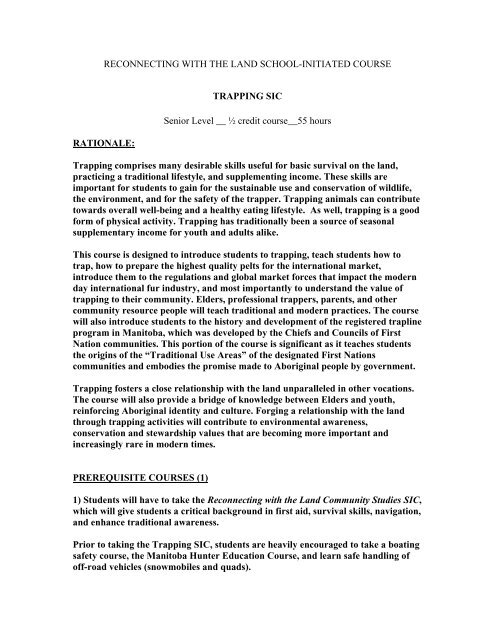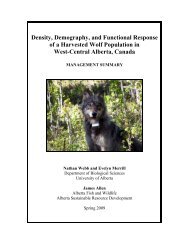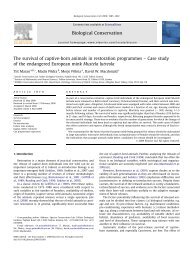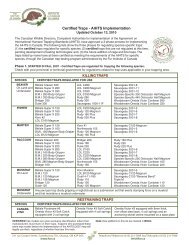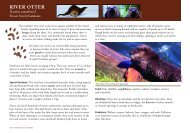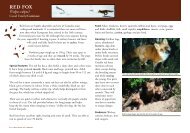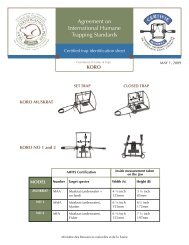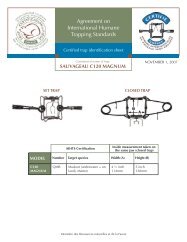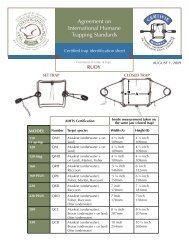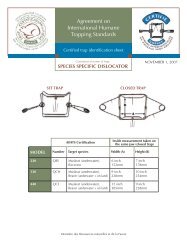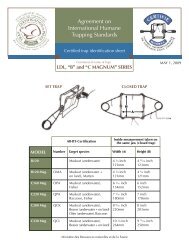Trapping - Fur Institute of Canada
Trapping - Fur Institute of Canada
Trapping - Fur Institute of Canada
Create successful ePaper yourself
Turn your PDF publications into a flip-book with our unique Google optimized e-Paper software.
RECONNECTING WITH THE LAND SCHOOL-INITIATED COURSERATIONALE:TRAPPING SICSenior Level __ ½ credit course__55 hours<strong>Trapping</strong> comprises many desirable skills useful for basic survival on the land,practicing a traditional lifestyle, and supplementing income. These skills areimportant for students to gain for the sustainable use and conservation <strong>of</strong> wildlife,the environment, and for the safety <strong>of</strong> the trapper. <strong>Trapping</strong> animals can contributetowards overall well-being and a healthy eating lifestyle. As well, trapping is a goodform <strong>of</strong> physical activity. <strong>Trapping</strong> has traditionally been a source <strong>of</strong> seasonalsupplementary income for youth and adults alike.This course is designed to introduce students to trapping, teach students how totrap, how to prepare the highest quality pelts for the international market,introduce them to the regulations and global market forces that impact the modernday international fur industry, and most importantly to understand the value <strong>of</strong>trapping to their community. Elders, pr<strong>of</strong>essional trappers, parents, and othercommunity resource people will teach traditional and modern practices. The coursewill also introduce students to the history and development <strong>of</strong> the registered traplineprogram in Manitoba, which was developed by the Chiefs and Councils <strong>of</strong> FirstNation communities. This portion <strong>of</strong> the course is significant as it teaches studentsthe origins <strong>of</strong> the “Traditional Use Areas” <strong>of</strong> the designated First Nationscommunities and embodies the promise made to Aboriginal people by government.<strong>Trapping</strong> fosters a close relationship with the land unparalleled in other vocations.The course will also provide a bridge <strong>of</strong> knowledge between Elders and youth,reinforcing Aboriginal identity and culture. Forging a relationship with the landthrough trapping activities will contribute to environmental awareness,conservation and stewardship values that are becoming more important andincreasingly rare in modern times.PREREQUISITE COURSES (1)1) Students will have to take the Reconnecting with the Land Community Studies SIC,which will give students a critical background in first aid, survival skills, navigation,and enhance traditional awareness.Prior to taking the <strong>Trapping</strong> SIC, students are heavily encouraged to take a boatingsafety course, the Manitoba Hunter Education Course, and learn safe handling <strong>of</strong><strong>of</strong>f-road vehicles (snowmobiles and quads).
STUDENT LEARNING OUTCOMES:General Outcome: (Class time)1a) Students will take part in the Mandatory Manitoba Trapper EducationCourse (12 hours) which qualifies the successful student to acquire a Manitobatrapping license.Specific Learning Outcomes:- Learn the pre- and post-contact history <strong>of</strong> trapping, including thedevelopment <strong>of</strong> the “registered trapline program” in Manitoba- Understand the rationale for conservation laws, regulation, policies, andlicensing that concern trappers in Manitoba, including the Agreement onInternational Humane <strong>Trapping</strong> Standards (AIHTS)- Develop students’ awareness <strong>of</strong> conservation, sustainable use, and theenvironment.- Identify good trapping areas.- Understand the importance and sustainability <strong>of</strong> a healthy balance in natureas it pertains to the environment surrounding trapping areas.- Understand the Agreement on International Humane <strong>Trapping</strong> Standards(AIHTS) and how it applies to Aboriginal trappers and their trappingpractice including trapping under Aboriginal and Treaty rights to trap.- Understand fur as a commodity and the importance <strong>of</strong> Europe as a marketfor fur.- Understand furbearer biology, seasonality, behaviour, and speciesmanagement, including parasites and diseases that affect furbearers.- Know how to use all parts <strong>of</strong> the animal, including carcass by-products (suchas beaver castors) and understand how to dispose <strong>of</strong> carcasses when thecarcass is not going to be used for country foods.General Outcome (Practical application)1b) Students will understand the basic techniques for humane trapping.- Participate in a demonstration <strong>of</strong> trap sets for a) Beaver and Otter, b)Marten, Fisher and Mink and Raccoon, c) Muskrat d) Lynx, Wolf, Coyoteand Fox and e) Weasels f) other species common to their area (like fox andsquirrel).- Be able to identify and use appropriate tools to set various traps according tospecies.- Demonstrate how to set traps and snares on land.- Demonstrate how to set traps and/or snares under ice (such as when trappingbeaver).- Skin, flesh, form and dry pelts appropriately and according to species.- Bait and lure appropriately according to furbearer species.2
- Be able to adjust and modify trap triggers.- Get free if accidentally caught in a trap.- Treat, repair and maintain traps and snares.- Partake in the consumption <strong>of</strong> furbearers and experience different ways <strong>of</strong>cooking furbearers’ meat.General Outcome:2) Students will come away with a general knowledge <strong>of</strong> fur markets and <strong>of</strong> theinternational issues surrounding the fur industry, including:o Auctionso <strong>Fur</strong> dealerso Consumers and fashiono Preparation <strong>of</strong> record keeping for a trapping businesso How to generate communications between fur sellers and buyerso Grading furs and identifying prime peltso Understand why some individuals or groups may not supporttrapping activities or the harvesting <strong>of</strong> animals.CONTENT OUTLINE AND TIME ALLOTMENTS:1a) Manitoba Trapper Education Course (new edition) including AIHTS 1 :12 hrs1b) Practical (on the land): trap setting, safety, pelting, handling, preparing35 hrs2) Understanding global market forces and the fur industry8 hrs55 hrsLEARNING APROACHES AND STRAGEGIES:• Teachers should consist <strong>of</strong> at least one local Elder and one certifiedtrapper instructor.• Manitoba Trapper Education courses will be largely classroom based. Itmust be taught by certified local trapping instructors (ManitobaWildlife Federation/ Manitoba Conservation).• Approximately 50% <strong>of</strong> the course should take place on the landaccompanied by several certified instructors, trappers and Elders toensure excellent student-teacher ratios.1 A person must be 12 years <strong>of</strong> age to apply for a trapping license. Children between12 and 14 must be accompanied by a “licensed trapper” when trapping. Peltscannot be sold by unlicensed trappers.3
• Teach the Mandatory Manitoba Trapper Education Course in earlyfall so that the field portion can take place starting in November.Students can take advantage <strong>of</strong> the fur sales that take place inJanuary and February. For winter/ spring courses, the next sale is inMay.• Squirrels are a good place to start with skinning for beginners as theirpelts are not worth as much as other species. Also, squirrels are<strong>of</strong>ten plentiful.• Discuss and debate the European fur ban and the need for the AIHTSas a trade agreement. Have the group play roles in a debate (such astrapper, fur buyer, animal rights activist, and members <strong>of</strong> theEuropean and Canadian parliaments).• Practical demonstrations, by teachers, Elders, and even skilledstudents should make up much <strong>of</strong> the course. This is particularlyimportant when it comes to trap and snare setting, and settingsnares and/or traps under ice.• Schedule presentations by fur buyers, sellers, and local Aboriginaldesigners. (High Schools would be able to apply for a careerdevelopment grant for field trips.)• Schedule tours <strong>of</strong> the auction houses or a visit to the Thompson furtables.• Have students compete with each other to produce the best quality furpelt- have a panel <strong>of</strong> judges grade them.• Donate pelts to local fur designers, or have students attempt to workwith furs to produce something wearable. Canadian AboriginalDesign Council can link trappers to with designers.• Share recipes. Ask Elders to share their best recipes too. Compilethese into a cookbook.• Share harvests with community, Elders, medically ill, single parents,senior centers, and community freezers.ASSESSMENT STRATEGIES:Assessments will vary but should include all skills, both practical and languagerelated,as well as knowledge and attitudes, as outlined in the student learningoutcomes (see summary list above). While the teacher has overall responsibility forensuring accurate and fair student assessment, this responsibility can be sharedwith Elders, pr<strong>of</strong>essional trappers, parents, and other community resource people,as appropriate.Since “doing”, “seeing” and “one-on-one” exchange with Elders, experts, andteachers comprises such an important aspect <strong>of</strong> this SIC, participation in at least80% <strong>of</strong> the class hours is mandatory. However, students will not receive marks forsimply attending class – they must demonstrate achievement related to the courselearning outcomes. Students should be aware <strong>of</strong> what they will be assessed on, andwherever possible, have the opportunity to take part in developing the evaluation4
criteria. It is critical that clear expectations are put in place regarding the level <strong>of</strong>trapping skills expected. Students who are beginning trappers may have differentexpectations than those that are experienced.The suggested learning approaches and strategies provide excellent tools forperformance-based assessment (e.g. skinning squirrels, debates). The particularapproaches used for assessment can vary, but will likely rely heavily onobservational assessments with tools such as anecdotal comments and checklistsused to record information. The Manitoba Trapper Education Course may havespecific assessment components (e.g. written test) that will be necessary toincorporate. Whenever possible, one-on-one assessment and evaluation methodsshould be applied. It is important that assessment methods be respectful <strong>of</strong> culturalpractices and protocols.Possible points <strong>of</strong> evaluation:Written• Written testing <strong>of</strong> knowledge, including provincial Trapper EducationExam for their MTEP certificatePractical: Skills, KnowledgeStudents will demonstrate:• the ability to convey in words and within the traditions <strong>of</strong> thecommunity the basic operation <strong>of</strong> what they have learned• skills in trapping• knowledge <strong>of</strong> fur markets• knowledge <strong>of</strong> international issues surrounding the fur industry• ability to work in a team• ability to work individually• ability to solve problemsAttitudesStudents will demonstrate• a good attitude towards each other, themselves and the natural life formsaround them• a willingness to participate in all activities• openness to others’ ideas• respect for themselves and othersStudents with natural leadership qualities or who are particularly skilledshould demonstrate• willingness to share their knowledge, do demonstrations, and to help othersto learnLiteracy and Language:Students will demonstrate• an effort to use their traditional language and traditional words5
LEARNING RESOURCES AND BIBILIOGRAPHY:The following should be mandatory materials:1) Manitoba Trapper Education Handbook2) AIHTS Instructors Curriculum for AIHTS Workshops for AboriginalInstructors (published by <strong>Fur</strong> <strong>Institute</strong> <strong>of</strong> <strong>Canada</strong>, 2004/ 2005) www.fur.ca.3) “Aboriginal <strong>Trapping</strong> and the AIHTS (25 minute video) Sept. 2001.4) “<strong>Fur</strong>: Fabric <strong>of</strong> a Nation” (26 minute video on the steps <strong>of</strong> producing worldclass furs- from trappers to designers to manufacturers). <strong>Fur</strong> Council <strong>of</strong><strong>Canada</strong>. www.furcouncil.com.5) Pelt handling manuals.6) DVD set “Focus on <strong>Trapping</strong>”. Published by the <strong>Fur</strong> <strong>Institute</strong> <strong>of</strong> <strong>Canada</strong>,www.fur.ca7) <strong>Fur</strong>bearers <strong>of</strong> <strong>Canada</strong>: Booklet published by the <strong>Fur</strong> <strong>Institute</strong> <strong>of</strong> <strong>Canada</strong>8) “The <strong>Fur</strong> Trade and the opening <strong>of</strong> <strong>Canada</strong>” <strong>Fur</strong> <strong>Institute</strong> <strong>of</strong> <strong>Canada</strong>The following can provide scope and ideas for Instructors:9) “Sustainable Forest Ecosystems”, by Manitoba Model Forest and ManitobaEducation, Citizenship and Youth. (Bob Austman).10) “Trappers: Stewards <strong>of</strong> the Land”. A booklet on trappers’ role in themanagement, stewardship, and conservation <strong>of</strong> furbearers. <strong>Fur</strong> <strong>Institute</strong> <strong>of</strong><strong>Canada</strong>, 2003. www.fur.ca11) “A Way <strong>of</strong> Life”. Government <strong>of</strong> the NWT. 1986. Includes recipes, trap sets,notes on humane trapping, as well as chapters on making waterpro<strong>of</strong> kamiksand snowshoes.12) BC Trapper Education Manual. By the BC Trappers’ Association. One <strong>of</strong>the most comprehensive and up to date trapper’s manuals. By Hatler andBeal.13) North American <strong>Fur</strong> Auctions (NAFA) in Winnipeg- gives tours by request.14) Thompson <strong>Fur</strong> Tables, in Thompson MB.15) Guidelines for Trapper Education Course Curricula in <strong>Canada</strong>, by FIC(also included in DVD set for “Focus on <strong>Trapping</strong>”)16) Wild <strong>Fur</strong>bearer Management and Conservation in North America, 1999,edited by Novak et al. Ontario Ministry <strong>of</strong> Natural Resources; DVD (wasoriginally in book form) produced by Ontario <strong>Fur</strong> Managers Federation,North Bay.17) The Alaska Native Knowledge Network (ANKN) is an AKRSI partner,established to assist Native people, government agencies, educators and thegeneral public in gaining access to the knowledge base that Alaska Nativeshave acquired through cumulative experience over millennia.http://www.ankn.uaf.edu/6


